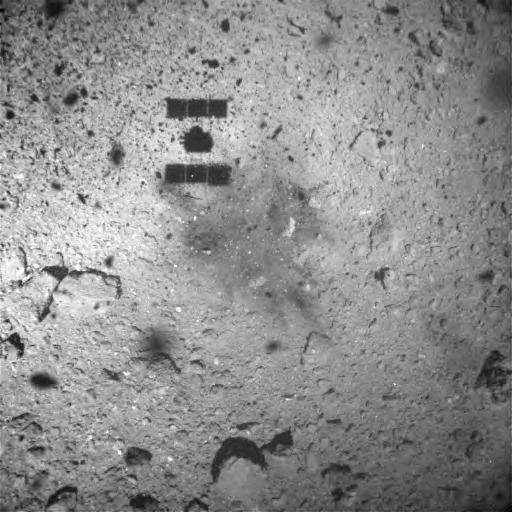Shadow Selfie! Japanese Asteroid Probe Snaps Amazing Post-Landing Pic

A Japanese asteroid probe commemorated its successful sample grab with a stunning post-landing photo.
The Hayabusa2 spacecraft captured the image on Thursday (Feb. 21), just a minute after it briefly touched down on the near-Earth asteroid Ryugu, blasted a metal "bullet" into the space rock, collected some of the ejected debris and rose into space once again.
Hayabusa2's shadow is clearly visible in the image, which was taken when the probe was about 82 feet (25 meters) above Ryugu's rugged surface. The touchdown site is obvious as well. [Japan's Hayabusa2 Asteroid Mission in Pictures]
"The color of the region beneath the spacecraft’s shadow differs from the surroundings and has been discolored by the touchdown," Japan Aerospace Exploration Agency (JAXA) officials wrote in a description of the photo, which was released yesterday (Feb. 24). "At the moment, the reason for the discoloration is unknown but it may be due to the grit that was blown upwards by the spacecraft thrusters or bullet (projectile)."
Hayabusa2 launched in December 2014 and arrived at the 3,000-foot-wide (900 m) Ryugu in June of last year. The mission is action-packed: The Hayabusa2 mothership dropped two hopping rovers and a lander onto the space rock's surface last fall, and it carries an additional "optional" hopper that may touch down in the near future as well.
And Hayabusa2 will make two more sampling sorties in the next few months. The first of these future operations will be much like last Thursday's operation — fire a bullet, collect some blasted-out material. But the second will slam a large "kinetic impactor" into Ryugu, creating a crater that Hayabusa2 will then sample for pristine, previously subsurface material.
If all goes according to plan, these three samples will come down to Earth in a special return capsule in December 2020. Scientists around the world will then study the asteroid dirt and rubble, looking for clues about the solar system's early history and evolution, and the role carbon-rich asteroids such as Ryugu may have played in life's emergence on Earth. (Such space rocks are thought to have delivered lots of water, as well as organic molecules, to our planet long ago.)
Breaking space news, the latest updates on rocket launches, skywatching events and more!
NASA has a similar mission operating now as well. The American space agency's OSIRIS-REx probe arrived in orbit around the 1,650-foot-wide (500 m) carbon-rich asteroid Bennu on Dec. 31 and is expected to grab a sample in mid-2020. The Bennu material will come down to Earth in a capsule in September 2023.
Mike Wall's book about the search for alien life, "Out There" (Grand Central Publishing, 2018; illustrated by Karl Tate) is out now. Follow him on Twitter @michaeldwall. Follow us on Twitter @Spacedotcom or Facebook.

Michael Wall is a Senior Space Writer with Space.com and joined the team in 2010. He primarily covers exoplanets, spaceflight and military space, but has been known to dabble in the space art beat. His book about the search for alien life, "Out There," was published on Nov. 13, 2018. Before becoming a science writer, Michael worked as a herpetologist and wildlife biologist. He has a Ph.D. in evolutionary biology from the University of Sydney, Australia, a bachelor's degree from the University of Arizona, and a graduate certificate in science writing from the University of California, Santa Cruz. To find out what his latest project is, you can follow Michael on Twitter.
